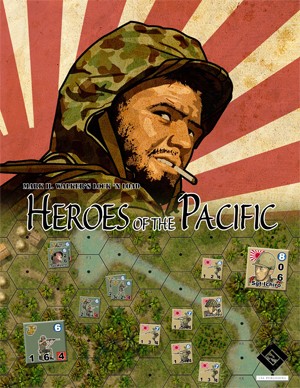
You will lead desperate Marines struggling ashore on Tarawa, face a counterattack of HA GO tanks at the Peleliu airfield, fight for Kitano Point on Iwo Jima, and more.
It isn’t, however, all about the Marines. Heroes of the Pacific comes chock full of the U.S. Army’s finest, as well as the Imperial Japanese Army. All drawn with the painstaking detail our fans have come to expect.
***
It’s a strange world. People suck an endless stream of reality programming from their TV, yet call sports lovers dumb, Kim Kardashian is famous for nothing, yet thousands of hard-working writers, musicians, and filmmakers are forced to eek out their living. Stranger still is Heroes of the Pacific. Well, sort of.
Firepower?
World War II-era Japanese are interesting to model. Although famed for their warrior spirit and discipline, they were poorly equipped. From 1943 on they were bringing a bolt-action knife (Arisaka bolt-action rifle) to the semi-automatic M1 Garand gun battle. This put them at a distinct disadvantage. The U.S. Marines marksmanship furthered it.
Hence, the standard Japanese rifle squad has a firepower of one. Just like their German counterparts. On the other hand, the Marines have double that (that’s two for the math challenged). The U.S. Army also has one firepower (smaller squads, and less training than Marines), but additional squads in a fire group aren’t halved—a nod to the Garand’s firepower.
Morale
The Japanese have a unique morale structure. They don’t shake. If they fail a damage check they are reduced. Sort of like the Somalis from Day of Heroes, but much tougher. They are tougher for a couple of reasons. First off, Japanese squads are three step units. A Squad that fails a Damage Check is reduced to a Half-squad. If that same Half-squad fails another Damage Check it is reduced to a smaller Half-squad. Fail again and they are dead.
Hidden Units
Argh, I hate them. They are the lamest of design ploys. Nevertheless, I understand that surprise Japanese attacks and snipers are much of the fun in any game modeling the Pacific theater. The game’s standard rules cover the snipers, just fine, but small groups of men ambushing Marine patrols or emerging from spider holes to fling satchel charges at defensive positions is something new. Here what I did.
Some scenarios allow Japanese to enter using Ninjutsu movement. The Japanese player merely points to a hex that the Japanese are to appear (it’s usually a Half-squad, but can be more), and rolls d6. If he rolls four or greater, he places the Japanese in the hex. Simple? Yes, but there is a bit more meat than first strikes the eye. One is added to the die if the hex is Heavy Jungle, making it easier for the Japanese to appear in that terrain. One is subtracted from the d6 if there is an enemy MMC in the hex, making it more difficult to appear right under the Americans nose, and the other results (1-3) are much more than “no effect.” The Japanese might be eliminated, might be placed in an adjacent hex of the American’s choice, or perhaps not placed at all. We think it works quite well, and without the muss of tracking hidden units.
Is there more? Well, of course there is. We have come up with simple rules for Banzai attacks that pull your head out of the rules, and put fun on the table. And the Marines have plenty of chrome, from spectacular 6-2 Leaders, through enhanced moral on their Shaken side, to their own, unique Skill cards.
Our Kind of Battles
And last, but not least, Heroes of the Pacific is chock full of the kind of battles we like to fight. Most are small—not tiny, but small. Although the game ships with a bunch of tanks, almost all the scenarios feature the infantry, with one or two armored fighting vehicles in a supporting role. Play testing has been fun… so much fun that I wonder why it took me so long to design. It’s just strange.
- No Time for Tea: A Preview of In Defeat, Defiance - Feb 16, 2012